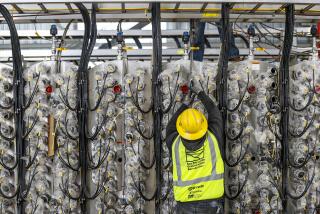DWP Project Preserves Reservoir Vistas
To the delight of many, a four-year, $85-million project to improve the water delivery system at the Upper and Lower Hollywood reservoirs has been completed, prompting officials to once again allow public access to the scenic area.
“It’s about time,” jogger Guillermo Roma, 36, said the other day as he completed a 3.1-mile run around the two reservoirs in the Hollywood Hills. “I missed running here because it’s so peaceful and beautiful.”
After the Sept. 11 terrorist attacks, the Los Angeles Department of Water and Power restricted public access to the Hollywood reservoirs and other DWP facilities to protect against threats to the system’s water quality and to ensure the project’s continuation.
DWP officials declined to talk in detail about heightened security measures, but said no threats against the Hollywood reservoirs had been detected.
“We didn’t have anything close to a terrorist-oriented threat,” said Richard Harasick, the DWP’s assistant director of water resources.
The project, officials and residents said, has accomplished its two major goals: ensuring water quality and preserving the reservoirs as scenic spots.
There’s also an added benefit. The sometimes-milky appearance of water from the tap has been eliminated by getting rid of air pockets created when the new facilities were built.
Conceived in the early 1990s, the improvement project was undertaken by the DWP to comply with federal and state regulations requiring stringent treatment for water stored in open-air reservoirs. Such treatment is deemed necessary because those bodies of water are exposed to surface water runoff that can affect quality.
Discussions have been underway for years about how best to deal with water quality at such places as the Silver Lake and Ivanhoe reservoirs in Silver Lake, and the Elysian Reservoir in Elysian Park.
At the Rowena Reservoir in the Los Feliz district, work on a 10-million-gallon underground storage tank was completed last year, meeting the goal of protecting water quality there.
To counter the concerns of nearby residents who feared that Rowena would lose its picturesque atmosphere, DWP engineers agreed to build an aesthetically pleasing landscape on top of the storage tank.
The artificial vista included two small ponds.
When discussions about the Hollywood project began, residents accustomed to the panoramic views of the reservoirs feared that they would lose the vistas. They had heard of the DWP plans to cover the Silver Lake and Ivanhoe reservoirs, an idea that has since been discarded, and of the comment by one DWP engineer, who bluntly told some residents that they would have to lose their scenic views.
“I didn’t want to lose that view, but I was afraid to tell the DWP that,” said one Hollywood Hills resident, who asked that he not be identified. “I guess I’m still afraid of them, but I’m glad we spoke up. They listened to us.”
Residents were skeptical about a DWP proposal to build a water filtration plant at the reservoirs. Then engineers focused on a plan that seemed to make everyone happy:
* Bury two 30-million-gallon tanks in a hillside next to the lakes, replacing the reservoirs, built in 1927, as the source of water for 500,000 DWP customers in the Hollywood area.
* Retain the two reservoirs as storage areas for water in case of an emergency, thus maintaining the vistas.
* Construct a pipeline from the San Fernando Valley to transport water to the two underground tanks.
As the work progressed, some wondered if the project was worth it. Dust, noise and street detours were commonplace.
But in the end, most in the area appreciated the result: newly landscaped hillsides that add to the secluded reservoirs’ idyllic ambience.
“It’s even a better place to run now,” said Roma, the jogger, “and it’s still close to the hustle and bustle of Hollywood.”
The DWP and Kiewit Pacific, an Omaha construction company with offices in Santa Fe Springs that handled the project, staged a gathering Saturday to thank residents for their patience during the project and to dedicate the new facilities.
“It’s something we can be proud of,” the DWP’s Harasick said.
More to Read
Sign up for Essential California
The most important California stories and recommendations in your inbox every morning.
You may occasionally receive promotional content from the Los Angeles Times.










